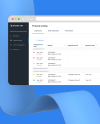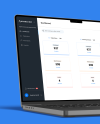Case study Avenue One
Real Estate New York, USA
Real Estate 2.0: Tech-Driven Success

Avenue One, a US leader in single-family home equity investment, facilitates the purchase of over 1,000 homes monthly with 10 employees.
- Business Intelligence
- Development
- Product Design
- Compliance
- Security

Analysis & Context
Avenue One faced several challenges due to the complex and evolving nature of the real estate market. Their home purchasing process was cumbersome and reliant on expensive external data. Managing thousands of transactions per month required exceptional coordination and precision, placing immense pressure on their employees.
Additionally, property inspections lacked standardization, further complicating operations. Avenue One needed a robust technological solution to streamline workflows, reduce reliance on external data, and enhance overall operational efficiency.

Transformation & Impact
Our approach followed these fundamental steps:
1. Transaction Manager:
We designed and built a transaction manager that allows their underwriters to identify targets and calibrate offers based on a wide range of real-time data and ratios.
2. Balance Between Efficiency and Performance:
Operating in a complex, constantly evolving environment, the goal was to streamline operations while maximizing returns.
3. Development of Internal Data:
The company developed its own data set and predictive analytics to overcome reliance on costly external data.
4. Workflow Optimization:
The new platform streamlined operational processes, ensuring the alignment of modules with the company's needs.
5. Standardization of Inspections:
The developed application standardized inspections, thereby facilitating inspectors' work.
6. Innovative System Architecture:
The system consists of four main modules, complemented by services and interfaces to facilitate user interactions, including a back office for employees and an application for inspectors.


Results
With the implementation of this new technological solution, Avenue One experienced a significant increase in operational efficiency.
The number of houses underwritten per day increased from 10 to 100, demonstrating the direct impact on the company's ability to process transactions faster and with greater accuracy.
The standardization of inspections reduced errors and improved the quality of evaluations, while simplifying the inspectors' work. The reduction in reliance on costly external data also led to substantial savings and greater autonomy in decision-making.
Finally, the new system architecture enabled better collaboration among internal teams, facilitating rapid adoption and effective adaptation to the changing market needs.





